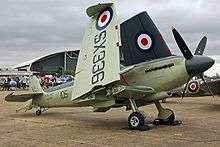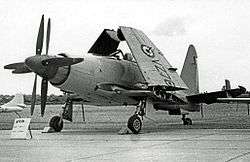Folding wing
A folding wing is a wing configuration design feature of aircraft to save space, and is typical of carrier-based aircraft that operate from the limited deck space of aircraft carriers. The folding allows the aircraft to occupy less space in a confined hangar because the folded wing normally rises over the fuselage decreasing the floor area of the aircraft. Vertical clearance is also limited in aircraft carrier hangar decks. In order to accommodate for this, some aircraft such as the Supermarine Seafire and Fairey Gannet have additional hinges to fold the wingtips downward, while others such as the S-3 Viking have folding tails. The F-14 Tomcat's variable-sweep wings could be "overswept" to limit deck space.
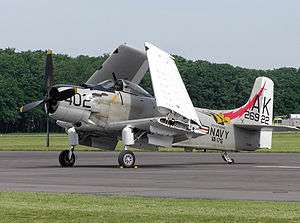
History
Short Brothers, the world's first aircraft manufacturer, developed and patented[1] folding wing mechanisms for biplane ship-borne aircraft like their Short Folder, the first patent being granted in 1913. The Folder's biplane wings were hinged so that they folded back horizontally alongside the fuselage,[2] usually being held in place by latches projecting sideways from the rear of the fuselage.
Description
Since the monoplane supplanted the biplane in the late 1930s, virtually all fixed-wing aircraft designed for shipboard duty have been equipped with folding wings. Notable exceptions include the SBD Dauntless, F2A Buffalo, and A4D/A-4 Skyhawk (all USN types), the Mitsubishi A5M, and Yokosuka D4Y (Japanese), and the Sea Harrier (British). All six are relatively compact designs.
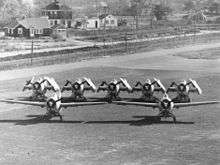
The Grumman-patented Sto-Wing aftwards-folding wing folding system, pioneered on the Grumman F4F-4 Wildcat, has been used since World War II on a number of Grumman-designed carrier aircraft,[3][4] a version of which is still in use in the 21st century on the Grumman E-2 Hawkeye shipboard airborne early warning (AEW) aircraft, and its C-2 Greyhound derivative.[5][6]
Another Grumman naval aircraft, the F-14 Tomcat, had variable-sweep wings which could be swept between 20° and 68° in flight. For parking, the wings could be "overswept" to 75°.[7]
A folding wing has some disadvantages compared to a non-folding wing. It is heavier and has more complex connections for electrical, fuel, aerodynamic and structural systems.
Many naval helicopters have rotor blades that can be aligned over the fuselage to save space on board ships.
Folding surfaces are rare among land-based designs, and are used on aircraft that are too tall or too wide to fit inside service hangars. Examples include the Boeing B-50 Superfortress and its folding tail. The Saab 37 Viggen and the Boeing 377 Stratocruiser have foldable rear fins that make them lower for entering hangars. The Boeing 777 (classic) twinjet wide-body airliner was offered with folding wingtips for confined airports. The new Boeing 777X models will feature a shorter and simpler folding wingtip than was planned for the earlier Boeing 777. This will provide an extra 7 metres (23 ft) of total wingspan in flight, yet the plane will still fit inside the same airport gates as the 777-200LR/777-300ER.
Gallery
Simple fold
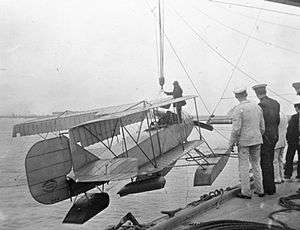 Short Folder S.64 being hoisted aboard the cruiser HMS Hermes (horizontal fold)
Short Folder S.64 being hoisted aboard the cruiser HMS Hermes (horizontal fold)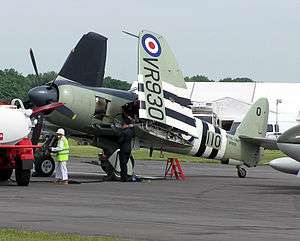
 Hawker Sea Hawk FGA.6
Hawker Sea Hawk FGA.6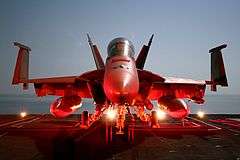 F/A-18E/F Super Hornet
F/A-18E/F Super Hornet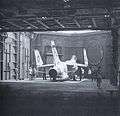 F-8H in an elevator
F-8H in an elevator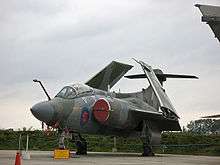 RAF Buccaneer S.2
RAF Buccaneer S.2_in_April_1956.jpg) An F11F Tiger with downward-folded wingtips
An F11F Tiger with downward-folded wingtips.jpg) folding wingtip of a Boeing 777X
folding wingtip of a Boeing 777X
Aftward fold
.jpg) Grumman F6F Hellcats of the US Navy. The patented Sto-Wing system was common to Grumman fighters of World War II.
Grumman F6F Hellcats of the US Navy. The patented Sto-Wing system was common to Grumman fighters of World War II..jpg) Argentinian Supermarine Walrus on a cruiser.
Argentinian Supermarine Walrus on a cruiser.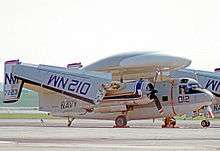 Grumman E-1 Tracer with Sto-Wing system folded wings.
Grumman E-1 Tracer with Sto-Wing system folded wings.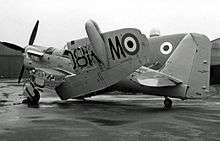
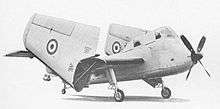
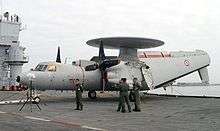 Grumman E-2 Hawkeye, which still uses a form of Grumman's Sto-Wing design.
Grumman E-2 Hawkeye, which still uses a form of Grumman's Sto-Wing design.
Double fold
Rotating wing
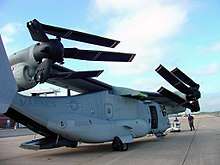 A V-22 Osprey with wings rotated parallel to fuselage
A V-22 Osprey with wings rotated parallel to fuselage
Over-swept wings
.jpg) A Grumman F-14 Tomcat with its wings in the "oversweep" position
A Grumman F-14 Tomcat with its wings in the "oversweep" position
Folding-wing aircraft on flight deck
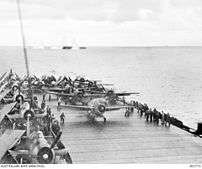 FM-2 Wildcats on USS Kitkun Bay (1944)
FM-2 Wildcats on USS Kitkun Bay (1944)_c1956.jpg) Vought F7U Cutlass on flight deck elevator
Vought F7U Cutlass on flight deck elevator_aerial_c1959.jpeg)
_leaving_Pearl_Harbor_in_April_1963.jpg)
 A Lockheed S-3 Viking on board USS John C. Stennis (2003)
A Lockheed S-3 Viking on board USS John C. Stennis (2003)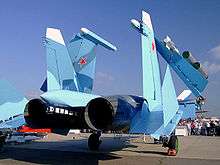
Notes
- Patents secured by Short Brothers including patents nos. 1792/13, 15727/13 and 28610/13, 5290/14, 20537/14 and 9276/15, see Barnes and James, pp. 92, 110
- Flight 1956
- Dwyer, Larry (19 February 2014). "The Aviation History Online Museum - Grumman F4F Wildcat". aviation-history.com. The Aviation History Online Museum. Retrieved April 2, 2016.
The F4F-4 was the first version of the Wildcat to feature a Grumman innovation, the Sto-Wing. The Sto-Wing used a novel approach using a compound angle folding-wing that was unique to Grumman...It was a successful design that was later used on the F6F Hellcat and TBF Avenger.
- "Wing-Folding Mechanism of the Grumman Wildcat - An American Society of Mechanical Engineers Historic Mechanical Engineering Landmark". asme.org. American Society of Mechanical Engineers. May 15, 2006. Archived from the original on 21 October 2015. Retrieved April 29, 2017.
- Dunn, Terry (27 April 2016). "Airplane Origami: How Folding Wings Work". Tested.com. Retrieved 30 May 2019.
- Thomason, Tommy (30 March 2011). "Grumman Sto-Wing Redux". Retrieved 30 May 2019.
- Leone, Dario (13 May 2014). "Two unknown F-14 Tomcat wing sweep stories to celebrate Top Gun Day". The Aviationist Blog. Retrieved 4 March 2019.
Bibliography
- Barnes C.H. & James D.N. Shorts Aircraft since 1900. London (1989): Putnam. p. 560. ISBN 0-85177-819-4.CS1 maint: location (link)
External links
![]()
